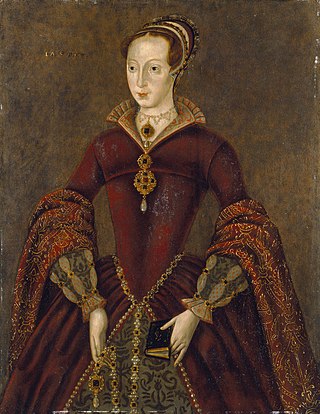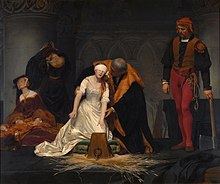
Anne Boleyn was Queen of England from 1533 to 1536, as the second wife of King Henry VIII. The circumstances of her marriage and execution by beheading for treason, made her a key figure in the political and religious upheaval that marked the start of the English Reformation.

Anne of the Thousand Days is a 1969 British historical drama film based on the life of Anne Boleyn, directed by Charles Jarrott and produced by Hal B. Wallis. The screenplay by Bridget Boland and John Hale is an adaptation of the 1948 play of the same name by Maxwell Anderson.

Thomas Boleyn, Earl of Wiltshire, 1st Earl of Ormond, 1st Viscount RochfordKGKB, of Hever Castle in Kent, was an English diplomat and politician who was the father of Anne Boleyn, the second wife of King Henry VIII, and was thus the maternal grandfather of Queen Elizabeth I. By Henry VIII he was made a knight of the Garter in 1523 and was elevated to the peerage as Viscount Rochford in 1525 and in 1529 was further ennobled as Earl of Wiltshire and Earl of Ormond.

Margaret Plantagenet, Countess of Salisbury, was the only surviving daughter of George Plantagenet, Duke of Clarence, a brother of Kings Edward IV and Richard III, by his wife Isabel Neville. As a result of her marriage to Richard Pole, she was also known as Margaret Pole. One of the few members of the House of Plantagenet to have survived the Wars of the Roses, she was executed in 1541 at the command of King Henry VIII, the second monarch of the House of Tudor, who was the son of her first cousin, Elizabeth of York. Pope Leo XIII beatified her as a martyr for the Catholic Church on 29 December 1886. One of her sons, Reginald Pole, was the last Catholic Archbishop of Canterbury.
Jane Boleyn, Viscountess Rochford was an English noblewoman. Her husband, George Boleyn, Viscount Rochford, was the brother of Anne Boleyn, the second wife of King Henry VIII. Jane had been a member of the household of Henry's first wife, Catherine of Aragon. It is possible that she played a role in the verdicts against, and subsequent executions of, her husband and Anne Boleyn. She was later a lady-in-waiting to Henry's third and fourth wives, and then to his fifth wife, Catherine Howard, with whom she was executed.

George Boleyn, Viscount Rochford was an English courtier and nobleman who played a prominent role in the politics of the early 1530s as the brother of Anne Boleyn, second wife of King Henry VIII. George was the maternal uncle of Queen Elizabeth I, although he died long before his niece ascended the throne. Following his father's promotion in the peerage in 1529 to Earl of Wiltshire and Earl of Ormond, he adopted his father's junior title Viscount Rochford as a courtesy title. He was accused of incest with his sister Anne during the period of her trial for high treason, as a result of which both were executed.
Elizabeth Boleyn, Countess of Wiltshire was an English noblewoman, noted for being the mother of Anne Boleyn and as such the maternal grandmother of Elizabeth I of England. The eldest daughter of Thomas Howard, 2nd Duke of Norfolk and his first wife Elizabeth Tilney, she married Thomas Boleyn sometime in the later 15th century. Elizabeth became Viscountess Rochford in 1525 when her husband was elevated to the peerage, subsequently becoming Countess of Ormond in 1527 and Countess of Wiltshire in 1529.
Mark Smeaton was a musician at the court of Henry VIII of England, in the household of Queen Anne Boleyn. Smeaton, together with the Queen's brother George Boleyn, Viscount Rochford, Henry Norris, Francis Weston and William Brereton was executed for treason and adultery with Queen Anne.
Thomas Culpeper was an English courtier and close friend of Henry VIII, and was related to two of his queens, Anne Boleyn and Catherine Howard. He is known to have had many private meetings with Catherine after her marriage, though these may have involved political intrigue rather than sex. A letter to him was found, written by Queen Catherine and signed, "Yours as long as life endures." Accused of adultery with Henry's young consort, Culpeper denied it and blamed the Queen for the situation, saying that he had tried to end his friendship with her, but that she was "dying of love for him". Eventually, Culpeper admitted that he intended to sleep with the queen, though he never admitted to having actually done so.

Sir Francis Weston KB was a gentleman of the Privy Chamber at the court of King Henry VIII of England. He became a friend of the king but was later accused of high treason and adultery with Anne Boleyn, the king's second wife. Weston was condemned to death, together with George Boleyn, Viscount Rochford, Henry Norris, William Brereton and Mark Smeaton. They were all executed on 17 May 1536, two days before Anne Boleyn suffered a similar fate.

The Chapel Royal of St Peter ad Vincula is a Chapel Royal and the former parish church of the Tower of London. The chapel's name refers to the story of Saint Peter's imprisonment under Herod Agrippa in Jerusalem. Situated within the Tower's Inner Ward, its current building dates from 1520, although the church was likely established in the 12th century. The church for working residents was the second chapel established in the Tower after St John's, a smaller royal chapel built into the 11th century White Tower. A royal peculiar, under the jurisdiction of the monarch, the priest responsible for these chapels is the chaplain of the Tower, a canon and member of the Ecclesiastical Household. The canonry was abolished in 1685 but reinstated in 2012.

The Execution of Lady Jane Grey is an oil painting by Paul Delaroche, completed in 1833, which is now in the National Gallery in London. It was enormously popular in the decades after it was painted, but in the 20th century realist historical paintings fell from critical favour and it was kept in storage for many decades, for much of which it was thought lost. Restored and displayed again since 1975, it immediately became a highly popular work once again, especially with younger visitors.
William Brereton, c. 1487/1490 – 17 May 1536, was a member of a prominent Cheshire family who served as a courtier to Henry VIII. In May 1536, Brereton was accused of committing adultery with Anne Boleyn, the king's second wife, and executed for treason along with her brother George Boleyn, Henry Norris, Francis Weston and a musician, Mark Smeaton. Many historians are now of the opinion that Anne Boleyn, Brereton and their co-accused were innocent.

Lady Jane Grey, also known as Lady Jane Dudley after her marriage and as the "Nine Days' Queen", was an English noblewoman who claimed the throne of England and Ireland from 10 to 19 July 1553.

The Boleyn Inheritance is a novel by British author Philippa Gregory which was first published in 2006. It is a direct sequel to her previous novel The Other Boleyn Girl, and one of the additions to her six-part series on the Tudor royals. * The novel is told through the first-person narratives of – Anne of Cleves, Katherine Howard, and Jane Boleyn, who was mentioned in The Other Boleyn Girl. It covers a period from 1539 until 1542 and chronicles the fourth and fifth marriages of King Henry VIII of England.

The Tudors is a historical fiction television series set primarily in 16th-century England, created and written by Michael Hirst and produced for the American premium cable television channel Showtime. The series was a collaboration among American, British, and Canadian producers, and was filmed mostly in Ireland. While named after the Tudor dynasty as a whole, it is based specifically upon the reign of King Henry VIII.
Events from the 1530s in England.

Catherine Howard, also spelt Katheryn Howard, was Queen of England from 1540 until 1541 as the fifth wife of King Henry VIII. She was the daughter of Lord Edmund Howard and Joyce Culpeper, a cousin to Anne Boleyn, and the niece of Thomas Howard, 3rd Duke of Norfolk. Thomas Howard was a prominent politician at Henry's court, and he secured her a place in the household of Henry's fourth wife, Anne of Cleves, where she caught the King's interest. She married him on 28 July 1540 at Oatlands Palace in Surrey, just 19 days after the annulment of his marriage to Anne. He was 49, and she was between 15 and 21 years old, though it is widely accepted that she was 17 at the time of her marriage to Henry VIII.

Épistre Contenant le Procès Criminel Faict à l'Encontre de la Royne Anne Boullant d'Angleterre, or A Letter Containing the Criminal Charges Laid Against Queen Anne Boleyn of England, is a 1,318-line poem written in French in 1536, by Lancelot de Carle, secretary to the French ambassador to England, Antoine de Castelnau.
















